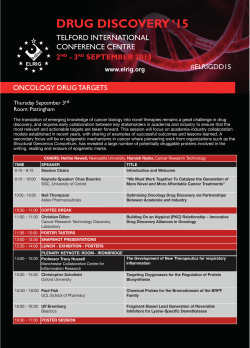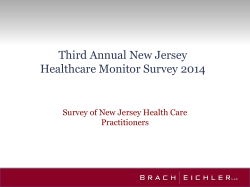
clinical pharmacy services in medical oncology unit, peshawar
April 30, 2015 Case Report • 2015 • vol.1 • 10-12 CLINICAL PHARMACY SERVICES IN MEDICAL ONCOLOGY UNIT, PESHAWAR, PAKISTAN Iftikhar, A.1; Jehanzeb, K.2; Aziz Ullah, K.1* 1Department of Pharmacy services, Northwest General Hospital and Research Centre, Peshawar, Khyber Pakhtunkhwa, Pakistan University of Peshawar, Khyber Pakhtunkhwa, Pakistan 2Department of Pharmacy, * azizkhanrph@gmail.com Abstract Problems arising due to drugs are more common in cancer patients and a major challenge to health care providers that affect patient’s quality of life. The purpose of this study was to identify drug related problems and highlight the impact of clinical pharmacy services on patient care In medical oncology unit. A total of 45 patient’s case histories were recorded in medical oncology unit at Hayatabad Medical Complex, on the standard designed questionnaire. The percentage occurrence of different disease like aplastic anemia 15(33.33%), leukemia 30(66.66%) were documented. The identified drug related problems were drug interactions 6 (42.85%), therapeutic duplication 2(14.28%), inappropriate dosage 2(14.28%), polypharmacy 4(28.57%). Pakistani Pharmacists have not been educated for a patient-care role. With the aim on individual patients, a well-established and responsible clinical pharmacy services will be a critical part of current-day health care, especially in developing countries. Keywords: clinical pharmacy, drug interactions, drug related problems, _______________________________________ http://pharmacologyonline.silae.it ISSN: 1827-8620 PhOL Iftikhar et al 11 (10-12) Introduction Drug related issues could be recognized as any event or condition including the drug therapy, which interferes on the other hand conceivably, interferes with the patient, attaining an ideal outcome of desired therapeutic goal. Drug related problems are frequent and may bring about decreased quality of life and even morbidity and mortality [1]. Drug related problems are common in hospitalized patients and increase the cost of therapy and lengthen the hospital stay [2]. Optimization of the drug therapy and control of drug related problems cannot be handled by any health care professional alone. Pharmaceutical care services can manage and prevent the drug related problems effectively [3]. Patients with malignancies have changed pharmacokinetic as well as pharmaco-dynamics parameters and they receive complex drug therapy that can increase the occurrence of drug-drug interactions and adverse drug events [4]. Clinical pharmacist participation in health care team has been demonstrated to have a positive impact on clinical, pharmaceutical and cost-effective indicators [5]. The Pharmacist has a key part in identification of drug related issues. This is far more critical on account of cancer patients, where a high number of treatment protocols and an extensive supportive therapy increases the number of drugs utilized [6]. The aim of the study was to identify the drug related problems and to highlight the impact of clinical pharmacy services on patient care in clinical setup. 5(11.11%). The nature of potential drug therapy problems, grouped to two, categories were identified namely, prescriber related potential DRPs and drug related potential DRPs. A total of 14 drug related problems were identified from 45 patient’s therapy charts. Most of the DPRs observed in our study resulted from the drug-drug interactions 6(42.85%), of the total DRPs identified which incorporated more of drug- drug interactions, followed by Polypharmacy 4(28.57%), ten drugs were prescribed as summarized in Figure 1. Keeping in mind poor financial position of majority population, the health care professional may prescribe minimum possible number of drugs, but it is necessary that maximum numbers of drugs may be prescribed when needed. The increase in total numbers, rates and patients with DRP could be explained by the more complete patient clinical data available to the clinical pharmacist when present in the health care providing team; this will allow the pharmacist to review patient’s drug therapy more effectively. Material and methods This study was performed from November 2014 to January 2015 in Hayatabad medical complex Peshawar Khyber Pakhtunkhwa, Pakistan. A standard questionnaire was used for data collection during ward round and data were collected from patient medical charts. A total of 45 patient’s case histories were recorded in medical oncology unit. Data were analyzed in Microsoft Excel. Acknowledgment The support of oncology staff of Hayatabad Medical Complex Peshawar is highly appreciated. Conclusion Involvement of clinical pharmacist in an oncology setup provides opportunity for the drug therapy management of cancer patients. Clinical pharmacists can be valuable to a health care providing team in oncology and can potentially lead to a decrease in health care expenses and to an improvement of the standard of patient care. Interacting with the health care team in ward rounds, identifying drug related problems as well as offering information to the patients and physicians can bring about more rewarding results for patients as well as hospital. Conflicts of interest None References 1. Viktil, K.K, Blix, H.S., The impact of clinical pharmacists on drug‐related problems and clinical outcomes. Basic Clin Pharmacol Toxicol 2008;102(3):275-80. Results and discussion 2. van den Bemt, P.M., Egberts, T.C., Brouwers, J.R., DrugA total of 45 patient’s drug therapy was assessed related problems in hospitalised patients. Drug Saf during the 90 days study period. Out of 45 patients 2000;22(4):321-33. 3. Hepler, C.D., Strand, L.M., Opportunities and responsibilities 41(91.11%) were male and 4(8.88%) were female, in pharmaceutical care. Am J Hosp Pharm 1990;47(3):533mean age was 25.4 (years), average hospital stay 543. was 5.63 (days) and the diagnoses of patients were 4. Wong, S.W., Gray, E.S., Clinical pharmacy services in aplastic anemia 15 (33.33%), acute lymphocytic oncology clinics. J Oncol Pharm Pract 1999;5(1):49-54. leukemia 15 (33.33%), Acute lymphoblastic 5. da Silva, N.M., The impact of pharmacist participation in a multidisciplinary team on an oncology ward compared with leukemia 10 (22.22%), and acute myeloid leukemia _______________________________________ a ward clinical pharmacy service. Eur J Hosp Pharm Sci http://pharmacologyonline.silae.it ISSN: 1827-8620 PhOL 6. Iftikhar et al Pract 2012;19(2):259-60. Cavaco, P., Dias, S., Ornelas, S., Ribeiro, N., Falcão, F., 12 (10-12) Pharmacotherapeutic follow-up in oncology. Eur J Hosp Pharm Sci Pract 2012;19(2):225-225. Figure 1. The identified drug related problems _______________________________________ http://pharmacologyonline.silae.it ISSN: 1827-8620
© Copyright 2025









